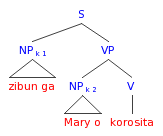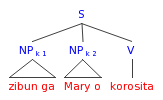- Michaeli loves himi
-
Principle B violation. The pronoun him
is bound in its binding domain by Michael,
which both C-commands it and
is coindexed with it. The binding domain
of him is the entire sentence.
- Hei loves Michaeli
-
Principle C violation. The R-expression
Michael is bound by him,
which both C-commands it and
is coindexed with it.
- Michael'sifather j loves himselfi
-
Principle A violation. The anaphor
himself is unbound.
Although Michael is coindexed
with himself, Michael
does not C-command himself.
The binding domain
of himself is the entire sentence.
-
Principle B violation. The pronoun him
is bound in its binding domain by Michael's father,
which both C-commands it and
is coindexed with it. The binding domain
of him is the entire sentence.
-
Principle A violation. Although the anaphor
herself is bound by Susan,
it is not bound within its
binding domain, i.e., within
the same clause. The binding domain
of himself is the embedded clause
John should marry herself.
-
Principle B violation. The pronoun her
is bound in its binding domain by Susan,
which both C-commands it and
is coindexed with it.
The binding domain
of her/i> is the embedded clause
John should marry herself.
Problem 4
- John wai Mary ga k zibunk/*i hihansita to itta
In this example zibun is behaving like an anaphor on both readings. On the k reading it is bound in its binding domain by Mary. This is consistent with Principle A. If it were a pronoun this would be a Principle B violation. On the ungrammatical i reading it is bound by John, which is not in its binding domain. If we assume it is an anaphor the ungrammaticality is explained because we have a Principle A violation. If it were a pronoun this would be consistent with Principle B and the ungrammaticality would be unexplained.
- John wai zibun gai Mary o k korosita to omotteiru
In this example zibun is behaving like a pronoun on the given reading. On this reading, it is bound by John, which is not in its binding domain. If we assume it is an anaphor this would therefore be a Principle A violation. If on the other hand it is a pronoun this would be consistent with Principle B.
- * John wai zibun gak Mary ok korosita to omotteiru
This example is definitely a Principle C violation. It may also be either a Principle A or Principle B violation, depending on our assumptions about zibun and Japanese sentence structure.
If we assume zibun is an anaphor, and we assume that Japanese has a VP, as follows:

However if we assume no VP, then then the anaphor is bound and there is no Principle A violation:

On the other hand, if we assume that zibun is a pronoun, then if Japanese has a VP there is no Principle B violation, and if Japanese has no VP there is a principle B violation.
Whether we assume that zibun is a pronoun or an anaphor, and whether we assume a VP or not, this example must be a Principle C violation. According to the assumptions given, the R-expression Mary is C-commanded by something that binds it.
Problem 6
Proposal: The definition of binding should be changed so that A binds B if and only if:
- A is coindexed with B
- A precedes B
We consider the following data with respect to this proposed revision of the Binding Theory:
-
(i) Although hei loves marshmallows, Arti is
not a big fan of Smores.
(ii) Hisiyearbook gives Tomi the creeps.
If the Binding Theory applies at D-structure, as proposed in problem 3, then there is a possible loophole for example (i), since it MIGHT involve movement. In that case, its D-structure source (the tree before movement applies) is plausibly:
-
Arti is
not a big fan of Smores, although hei loves marshmallows.
On the other hand, neither of these examples is problematic for our old definition of binding, which used C-command instead of precedence. In both cases the R-expression is unbound, because it is not C-commanded by the pronoun it coindexed with. Thus, on the C-command theory, there is no Principle C violation. Since this correctly predicts the given grammaticality judgments, the C-Command theory is the better theory with respect to this data.